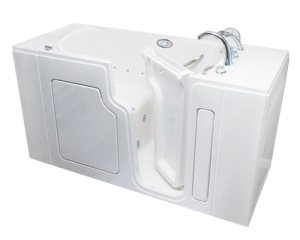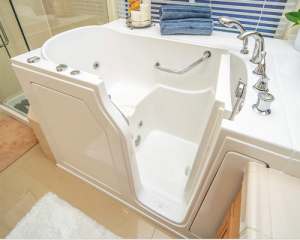- Cost: Depends on tub model
- Free purchase and installation quote? Yes, in-home consultation
- Tub types: Whirlpool
- Dimensions: Depends on tub model
- Threshold/step-in height: 4 inches (′′)
- Door style: Inward-swinging
- Water capacity: Depends on tub model
- ADA compliant: Yes
- Standout feature(s): Anti-scald technology, ultra-low threshold, aromatherapy
- Warranty: Two-year warranty on caulking; lifetime warranty on all else
The Five Best Walk-In Bathtub Brands of 2025: Tested by our Experts
Key Takeaways
- We recommend five walk-in bathtub brands as our top picks based on factors like their safety features, optional add-ons, and customer service.
- Walk-in bathtubs offer safety, therapeutic advantages, and convenience features, either as standard features or as add-ons.
- All of the brands reviewed here offer customization, which can change the final cost.
- Some of these brands only offer walk-in bathtubs, while others offer walk-in showers as well.
Falls are one of the most common causes of injuries for older adults, and while they can happen anywhere, one of the most common places falls happen is the bathroom.
Along with stair and wheelchair lifts, walk-in tubs are one way older adults can stay safe and maintain their independence at home, while also taking advantage of the therapeutic benefits of a walk-in tub. The walk-in tubs we researched and recommend here include multiple safety features that come standard, and therapeutic features designed to ease pain and calm the mind. An added bonus is that they also enhance your home space and make your environment more comfortable.
But which walk-in tub is best for you? That depends on how you want to use it. “It is easier to place less expensive, adaptive equipment like a shower chair or bench into walk-in showers or [standard] tubs, which further reduces the risk of falls,” said Nelin Krull, clinic director, physiotherapist, and co-owner of Myofascial Release Mississauga located in Ontario, Canada. “Walk-in tubs usually have a built-in seat, which is convenient and offers increased safety,” Krull said.
We’ve researched nine of the most popular walk-in tub brands, and chose five to recommend based on our research and testing. We took a close look at each brand’s safety and spa features, add-ons, and options for customization. Keep reading to find out what we learned and who we recommend these brands for.
And to check your falls risk and get safety tips, take NCOA’s Falls Free CheckUp®.
Best walk-in tubs in 2025
- Safe Step: Best Walk-in Tub for Customization
- Ella’s Bubbles: Best Walk-in Tub for Couples
- Independent Home: Best Walk-in Tub for Seniors
- American Standard: Best Luxury Walk-in Tub
- Kohler: Best Combination Walk-in Tub and Shower Combination
What we look for in walk-in tubs
We found several important factors when testing and reviewing walk-in tubs, including:

Safety features
Safety features provide stability and peace of mind and include ultra-low thresholdsⓘ A walk-in tub’s threshold is the measure of how high the step-in is from the floor. , anti-slip floors, and more.

Convenience features
Convenience features can make your bathing experience easier, regardless of your range of motion. Convenience features include no-strength handlesⓘ Designed to require minimal effort to use, making them easier for people with joint pain. , handheld shower wands, and more.

Therapeutic features
Therapeutic features can be included or purchased as an add-on. These include rainfall shower heads, massage jets, and more.

Customization options
Many buyers customize their walk-in bathtub to fit their space. Walk-in bathtub customizations include different dimensions, finishes, and colors.
Safe Step: Best Walk-In Tub for Customization
Our expert take on Safe Step
We chose Safe Step for its “Best Walk-In Tub for Customization” because its products are all tailored to the specific needs and home layout of the client. Safe Step provides free in-home consultations for all buyers, providing quotes based on the available space, as well as the optional costs for therapeutic or convenient add-ons. Safe Step offers three different walk-in options, so users can choose the tub that works best for them. Safe Step has its own installation team which is trained, certified, and insured. But you can hire your own installer if you want.
Our mobility expert’s take
Who may love Safe Step
- Buyers looking for a customized walk-in bathtub
- Those looking for a walk-in tub with comprehensive safety features
- Users looking for multiple walk-in bathtub options
Who may want to avoid Safe Step
- Buyers who want to know the price without an in-person consultation
- Those wanting more responsive customer service
- Buyers looking for therapeutic features included in the base price
Customer reviews on Safe Step
“The tub is living up to expectations. The jets are great, and my wife gets so relaxed that she doesn’t want to get out of the tub.”
— David H., verified buyer
“I love everything about my new Safe Step Walk-In Tub. It’s easy to get into, and the jets are outstanding. I have a lot of arthritis, and it certainly helps my stiff joints.”
— Donna S., verified buyer
Ella’s Bubbles: Best Walk-in Tub for Couples
Our expert take on Ella’s Bubbles
We chose Ella’s Bubbles as the “Best Walk-in Tub for Couples” because the brand offers walk-in tubs with multiple seats and additional space. This allows couples to share a walk-in bathtub without compromising their safety. Not many walk-in tub manufacturers make tubs with two doors, so our Reviews Team likes this unique offering. But it’s worth noting that you’ll need more space to fit a walk-in tub with two doors if you choose the outward-swinging option.
We also like that therapeutic features like massaging water jets with ozone bubbles are included at no additional charge.
Ella’s Bubbles has its own installation team which is trained, certified, and insured. But you can hire your own installer if you want.
Our mobility expert’s take
Who may love Ella’s Bubbles
- Buyers who want multiple bathtub options
- Taller and/or larger people who need a larger walk-in tub
- Couples who want a walk-in tub with multiple seats
Who may want to avoid Ella’s Bubbles
- Buyers looking for a more budget-friendly option
- Buyers who want a quote without an in-person consultation
- Users looking for a simple walk-in tub without extra features
- People with limited space in their bathrooms
Customer reviews on Ella’s Bubbles
“What a great company to work with, who were very responsive and very appreciative of their customers. They quickly handled problems, and I recommend them wholeheartedly.”
— Bob G., verified buyer
“We love our Ella’s Bubbles tub. We researched other brands available and chose Ella. The function, fit, and finish to us eclipses the competition we considered.”
— Lane S., verified buyer
Independent Home: Best Walk-in Tub for Seniors
Our expert take on Independent Home
We chose the Independent Home brand as the “Best Walk-in Tub for Seniors” because of its comprehensive safety features, standard spa features like hydrotherapy jets, aromatherapy, and electronic keypad, and the website’s ease of use.
Independent Home offers in-home consultations to customize their walk-in tubs to your living space. All Independent Home walk-in tubs feature the standard spa package, so you can receive hydrotherapy, aromatherapy, and chromotherapyⓘ Chromotherapy, also known as color therapy, uses colored lights to help make subtle changes in our moods. .
But because Independent Home only offers variations on one bathtub model, it may not be right for those looking for more variation or customization options. If you prefer customization options, we recommend Safe Step.
Independent Home has its own installation team which is trained, certified, and insured. But you can hire your own installer if you want.
Our mobility expert’s take
Who may love Independent Home
- Buyers who want a bathtub with spa features without paying extra
- People who don’t want to make renovations to their bathroom
- Those who want a walk-in tub with comprehensive safety features
Who may want to avoid Independent Home
- Buyers who want a wider variety of bathtub shapes or sizes
- Those looking for a choice of colors to coordinate with their bathroom
- Buyers who prefer a walk-in bath and shower combination
Customer reviews on Independent Home
“The installers were superb, and everything is working great. No problems at all, and the guys were the best.”
— Willie M., verified buyer
“I am slightly handicapped, and it has been very convenient for me. The two installers were outstanding and did everything I asked.”
— Larry L., verified buyer
American Standard: Best Luxury Walk-in Tub
Our expert take on American Standard
We chose American Standard as the “Best Luxury” walk-in tub brand because its tubs include comfort features like 44 targeted jets, chromotherapy, aromatherapy, hydrotherapy, and hygiene therapy, all standard and without extra charges. American Standard offers five walk-in tub options, all with different dimensions, colors, and door locations.
Prices vary, but based on our research and mystery shopping we’ve found American Standard tends to be more expensive than most other walk-in tubs on this list (with the exception of Kohler).
American Standard has its own installation team which is trained, certified, and insured. But you can hire your own installer if you want.
Our mobility expert’s take
Who may love American Standard
- Buyers looking for a soaker tub with comfort features included
- Those looking for a walk-in tub that can be bought from home improvement stores or online retailers
- Buyers who want to buy from a trusted name in home appliances
Who may want to avoid American Standard
- Buyers who want a more customizable walk-in tub
- Users who want a simpler tub
- Those who would prefer to buy their tub directly from the manufacturer
Customer reviews on American Standard
“Love the tub. It fills fast and drains even faster. It works great on my arthritic joints and relaxes me for a good night’s sleep.”
— Jay F., verified buyer
“I am thoroughly enjoying my walk-in tub. I wish I had bought it much earlier. I know that it helps my circulation and relaxes my muscles.”
— Lois M., verified buyer
To learn more about American Standard walk-in tubs, take a look at our full review.
Kohler: Best Walk-in Tub and Shower Combination
Our expert take on Kohler
We chose Kohler as the brand with the “Best Walk-In Tub and Shower Combination” because it includes a handheld, multifunction handshower with three spray settings and a gooseneck shower arm with multiple shower head styles. This allows users the option to stand or sit in their walk-in tub, while still including standard safety features.See more of our picks in our review of the best walk-in tub and shower combinations.
Kohler has a leading worldwide reputation, but with that reputation comes higher prices than average. Kohler also requires you to use a Kohler-certified installer, which also tends to be more expensive.
Our mobility expert’s take
Who may love Kohler
- Buyers looking for a walk-in tub they can bathe and shower in
- Those looking for a highly customizable designer walk-in tub
- Those who want a lifetime warranty
Who may want to avoid Kohler
- Buyers who don’t want to pay for Kohler-certified installation
- Users who want more size or shape options
- People who only need a standard walk-in tub
Customer reviews on Kohler
“It really dressed up the bathroom beautifully. Filling, draining, and heating are excellent, and the jets and warmth are wonderful therapy.”
— James, verified buyer
“I was most satisfied with how comfortable it is once you’re in it with the jets on. It also puts out heat and relaxes you.”
— George, verified buyer
To learn more about Kohler walk-in tubs, check out our full Kohler walk-in tub review.
How we test the best walk-in tubs
Walk-in tubs usually include three different types of features: safety, therapeutic, and convenience. Safety features are typically included in the cost of the walk-in tub, therapeutic features are usually add-ons, and convenience features help those with mobility issues.
After looking at each brand’s models, we research the brands as a whole. This includes interacting with their customer service teams, and scheduling in-home consultations to determine each brand’s typical installation price. We also take a look at the warranties offered.
Figure 1, A member of our Reviews Team tests the size of a walk-in tub

How much do walk-in tubs cost?
Walk-in tubs can vary in price depending on customization. In general, walk-in tubs cost from $2,000–$10,000 for the tub and $1,000–$20,000 for installation.
How to save money on walk-in tubs
If you know a plumber or handyman, you could save thousands on installation fees. Some brands require a brand-certified technician to install your tub, though, so keep this in mind and ask a lot of questions from the brand’s customer service team when deciding which walk-in bathtub brand to purchase.
Medicare and private insurance don’t usually cover the cost of walk-in bathtubs, but many of these bathtub brands offer discounts. Buyers can also take advantage of community and local organizations as well as government programs to assist with the cost of the tub and/or installation.
The U.S. Department of Agriculture offers Rural Repair and Rehabilitation grants and loans to help limited-income people who don’t qualify for other financing to modernize and upgrade their homes, including the addition of walk-in tubs. You can visit their website to find out more details and fill out an application.
If you’re not sure what you need to accommodate your mobility needs, also consider an evaluation by a physical or occupational therapist. You can find occupational therapists with home modification experience at the Home Modification Occupational Therapy Alliance. They can help you decide if a walk-in tub is best for you and what customizations are worth purchasing. Or they may offer alternatives that are more effective and affordable.
Special features to consider in walk-in tubs
- Aromatherapy and chromotherapy
- Hydro massage jets
- Heated seats and backrests
Safety features to consider in walk-in tubs
- Ultra-low thresholds
- Anti-slip floors and seats
- Built-in grab bars
Who should use a walk-in tub
Anyone who might be concerned about their safety in the bathroom may benefit from a walk-in bathtub. Walk-in bathtubs can help older adults to continue living independently in their own home without risking their safety. They’re also a good option for people with mobility issues or who need assistance when bathing.
Table 1, Compare walk-in tubs as of 2025
|
Safe Step
Check Price
|
Ella’s Bubbles
Check Price
|
Independent Home
Check Price
|
American Standard
Check Price
|
Kohler
Check Price
|
|
|---|---|---|---|---|---|
| Cost | Depends | Depends | Depends | Depends | Depends |
| Threshold / step height (inches) | 4″ | 6″ | Low-entry | 6″ | 3″ |
| ADA compliant | Yes | Yes | Yes | Yes | Yes |
| Door style | Inward-swinging | Inward- or outward-swinging | Inward- or outward- swinging | Inward- or outward- swinging | Inward- swinging |
Bottom line
After researching and testing nine walk-in tubs brands, we recommended five. Safe Step is our choice for best walk-in tub for customization, Ella’s Bubbles is best for couples, Independent Home is best for older adults, American Standard is the best luxury, and Kohler is the best walk-in tub and shower combination.
All of the brands included here have comprehensive safety features built in, and some offer standard therapeutic and convenience features as well.
We also looked at these brands as a whole, checking out their contact options, speaking with their customer service teams, and scheduling in-home consultations. Having a walk-in tub installed is a big and expensive decision that can’t be easily reversed. Before you make a commitment or sign a contract, make sure to consider your budget, your current and future physical needs, and your lifestyle.
Questions? Email us at reviewsteam@ncoa.org.
Frequently asked questions
Walk-in tubs typically cost between $2,000–$20,000, but price can vary based on customizations and sizes.
Whirlpool tubs have jets that spray air or water to massage sore muscles. Soaker tubs have higher walls that allow users to submerge up to their neck.
Walk-in tubs are safer than traditional bathtubs because they include a lower step-in threshold, a built-in seat, grab-bars, non-slip floors, and other safety features.
For people with mobility challenges, difficulty getting in and out of a standard tub, and/or at risk of falling, walk-in tubs can be well worth the expense.
Health insurance policies don’t usually cover walk-in tubs. But many policies may cover durable medical equipment (DME), such as tub benches and shower chairs, to help you get in and out of your tub more easily.
Walk-in tubs are made of fiberglass, with a gelcoat or acrylic topcoat for a smooth finish.
Most walk-in tubs come with a warranty. If it’s not listed on the brand’s website, check with the manufacturer before you make a commitment.
Most walk-in tubs hold 50–80 gallons of water.
Sources
- Mooventhan A, Nivethitha L. Scientific Evidence-Based Effects of Hydrotherapy On Various Systems of the Body. North American Journal of Medical Sciences. May 2014. Found on the internet at https://pmc.ncbi.nlm.nih.gov/articles/PMC4049052/
- Azeemi STY, Raza SM. A Critical Analysis of Chromotherapy and its Scientific Evolution. Evidence-Based Complementary and Alternative Medicine. December 2005. Found on the internet at https://pmc.ncbi.nlm.nih.gov/articles/PMC1297510/
- Single Family Housing Repair Loans & Grants. U.S. Department of Agriculture. Found on the internet at https://www.rd.usda.gov/programs-services/single-family-housing-programs/single-family-housing-repair-loans-grants











